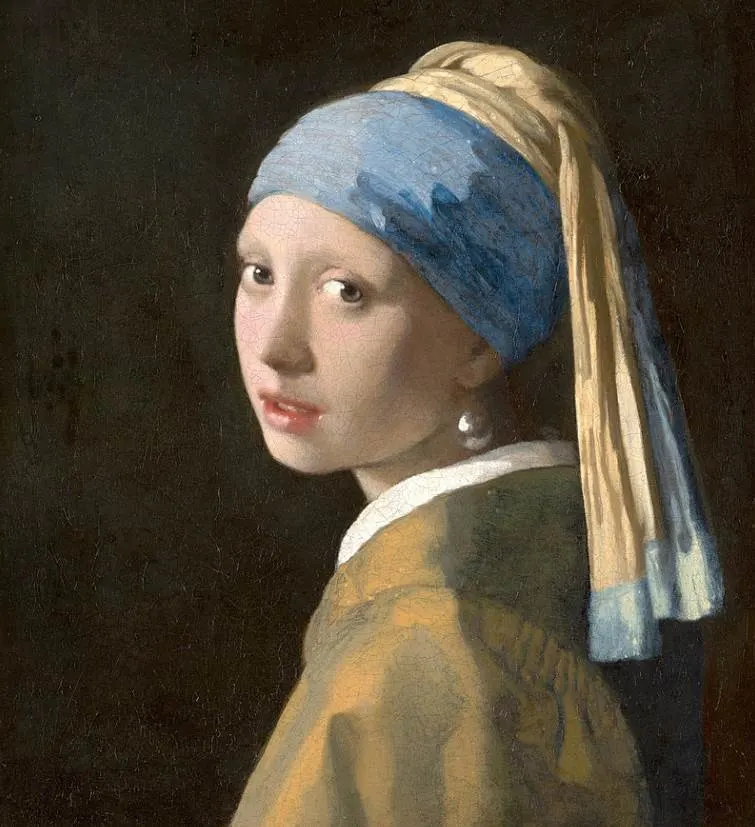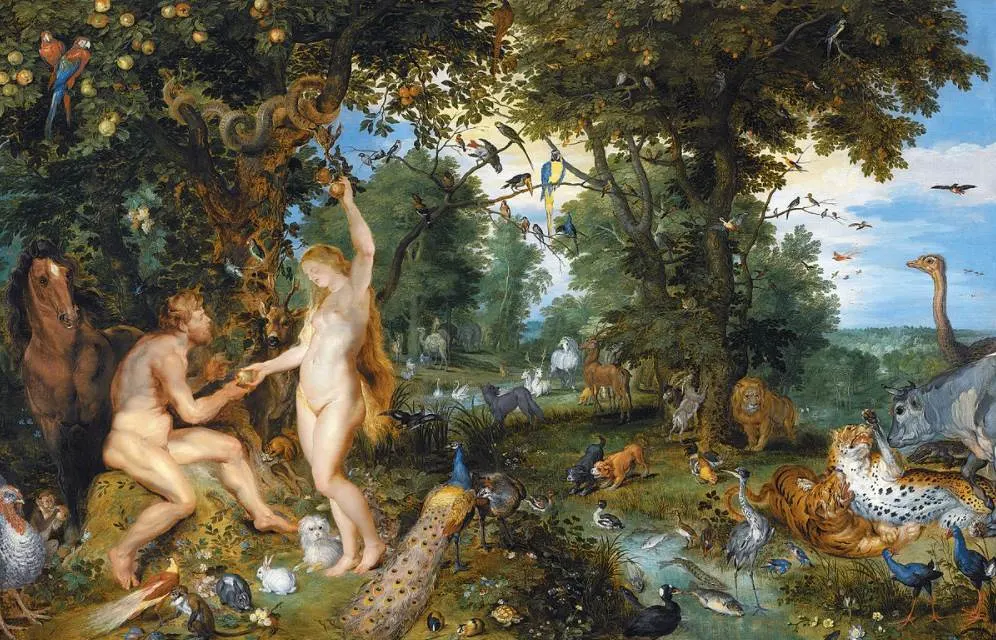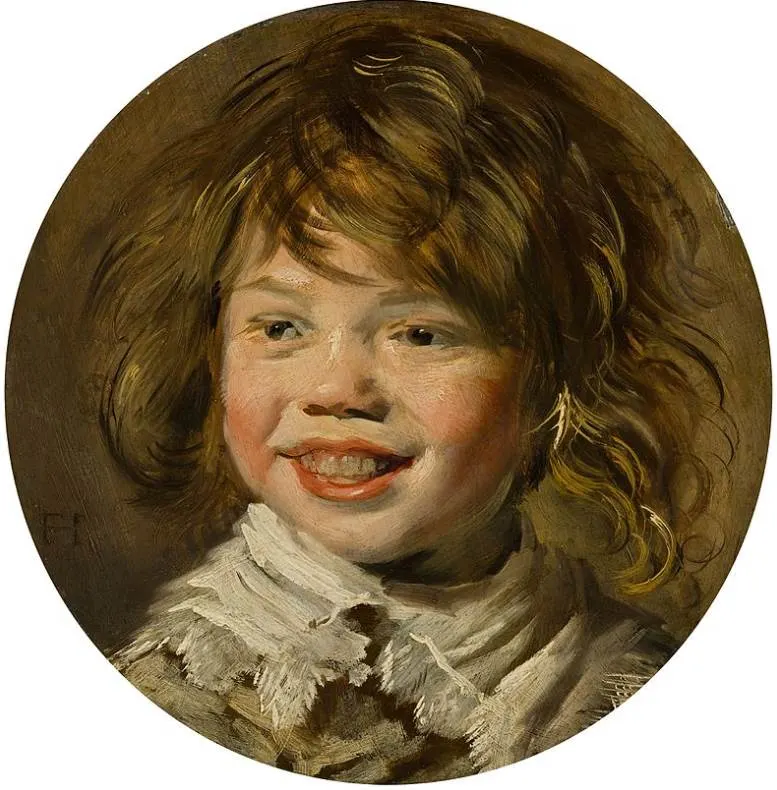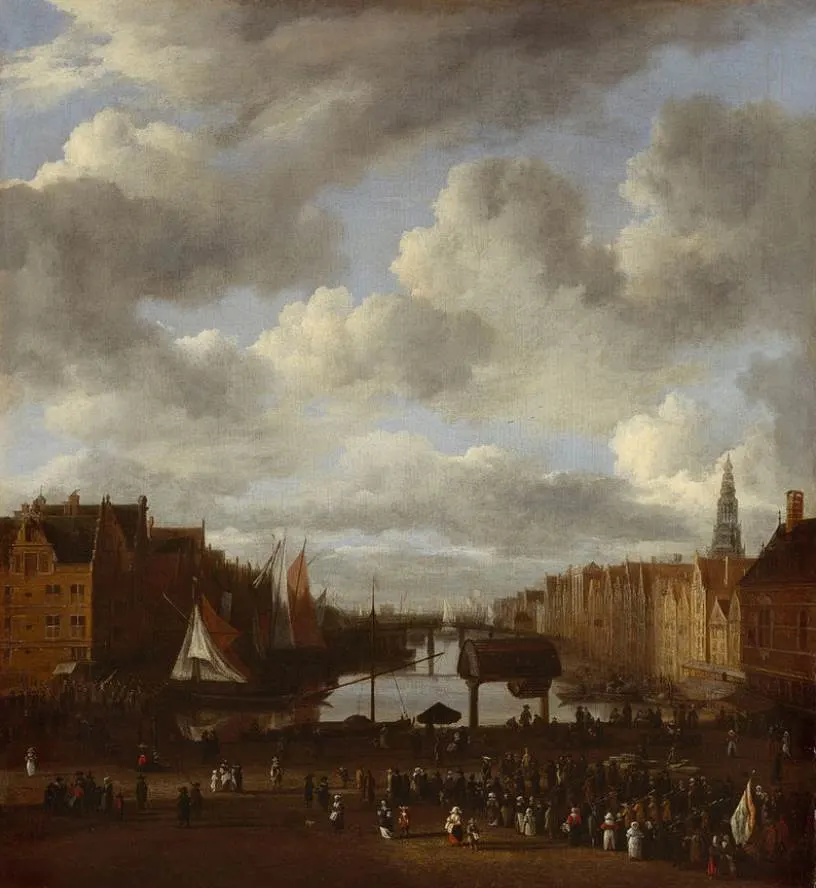The heart of art museums in the Netherlands is Museum Square in Amsterdam. This public space is where you can find the Rijksmuseum, the Van Gogh Museum, and the Stedelijk Museum Amsterdam.
One of the most fascinating museums to visit outside of Amsterdam is called the Mauritshuis in The Hague.
It’s situated right next to “Het Torentje” and the “Binnenhof,” a collection of government buildings in the heart of the city.
It is housed in a 17th-century building that once served as the residence of a Dutch count named John Maurice of Nassau (1604-1679).
The museum holds the so-called Royal Cabinet of Paintings, a royal collection that features a total of 854 objects, including some of the most famous Dutch Golden Age paintings by Dutch artists.
Below, you’ll find some of the most famous paintings on display at the Mauritshuis, artworks that you can’t miss when you visit this great museum.
1. Girl with a Pearl Earring – Johannes Vermeer
- Date created: 1665
- Dimensions: 44.5 × 39 centimeters (17.5 × 15 inches)
Girl with a Pearl Earring is the main attraction at the Mauritshuisn the most famous painting by Vermeer. This enigmatic painting has mystified viewers for centuries and has gone by several names throughout its history.
It’s believed that the painting depicts the daughter of Johannes Vermeer (1632-1675), the Baroque painter who lived during the Dutch Golden Age. It has been hanging in the museum since 1902 and gained worldwide attention as it has been featured in various forms of media.

2. The Anatomy Lesson of Dr. Nicolaes Tulp – Rembrandt van Rijn
- Date created: 1632
- Dimensions: 216.5 × 169.5 centimeters (85.2 × 66.7 inches)
The Anatomy Lesson of Dr. Nicolaes Tulp is a fascinating painting by Rembrandt van Rijn (1606-1669), the other world-famous master of the Dutch Golden Age. As the name of the painting suggests, we can see Nicolaes Tulp explaining to his students where various muscles in the arm are located.

In reality, various figures who are closely listening to the experienced surgeon are doctors who paid Rembrandt a commission to be included in the painting. Tulp was the official city anatomist of Amsterdam and held a public dissection once a year for the Amsterdam Guild of Surgeons.

3. The Garden of Eden with the Fall of Man – Rubens & Jan Brueghel the Elder
- Date created: 1615
- Dimensions: 74.3 × 114.7 centimeters (29.3 × 45.2 inches)
The Garden of Eden with the Fall of Man is a painting that is credited to both Peter Paul Rubens (1577-1640) and Jan Brueghel the Elder (1568-1625). Rubens was the man who painted the main figures in the Garden of Eden while Brueghel painted the animals and trees.
This type of painting was one of many Baroque masterpieces for which the duo collaborated. With the abundance of exotic animals, one of Jan Brueghel the Elders’ specialties, the artists aimed to turn these works into spectacles for the general public. Most people had never seen such creatures so this certainly succeeded.

4. Laughing Boy – Frans Hals
- Date created: 1625
- Dimensions: 30.45 centimeters in diameter (11.99 inches)
Laughing Boy is one of the most distinctive paintings of the “Tronie” genre. These were paintings that were popular with both Dutch and Flemish artists in which often exaggerated facial expressions were the main subject matter.
Frans Hals (1582-1666) was one of the leading portraitists of the Dutch Golden Age and lived and worked in Haarlem, a city near Amsterdam, during his lifetime. This particular painting is distinctive because it has a circular shape.

5. View of the Dam and Damrak at Amsterdam – Jacob van Ruisdael
- Date created: 1670s
- Dimensions: 46.8 x 43 centimeters (18.4 x 16.9 inches)
View of the Dam and Damrak at Amsterdam is a painting that provides us with a birdseye of a crowd watching a procession at Dam Square in the 17th century. This is the main square in Amsterdam and the location of the Royal Palace of Amsterdam, a building completed recently at the time in 1665.
Damrak was a canal leading up to Dam Square back then but has been turned into a wide avenue in the city. The parade in the painting involves the civic guard of Amsterdam. Jacob van Ruisdael created another version of this subject which is part of the Frick Collection in New York City.

6. View of Delft – Johannes Vermeer
- Date created: 1660-1661
- Dimensions: 96.5 × 115.7 centimeters (38 × 45.6 inches)
View of Delft is another amazing painting by Johannes Vermeer and is a fascinating work in his oeuvre. It depicts the home city of the artist, a city between Rotterdam and The Hague. It’s only one of 3 paintings depicting his native city, with only “The Little Street” surviving today.
It’s unclear when he completed this work, but an analysis of the buildings has concluded that it was completed in the early 1660s. That’s because the bells in the tower of the “New Church” weren’t present yet. The artist painted this work looking from an elevated position in the southeast of the city.

7. The Goldfinch – Carel Fabritius
- Date created: 1654
- Dimensions: 33.5 × 22.8 centimeters (13.2 × 9 inches)
The Goldfinch is a painting depicting a life-sized goldfinch that is chained to the wall. Dutch artist Carel Fabritius (1622-1654) lived in the same city as Johannes Vermeer and passed away during the gunpowder explosion in the city in 1654.
This painting used a trompe-l’œil effect to depict the bird and was still present in the artist’s studio when he died. The goldfinch has been a popular bird in the world of art since at least the Renaissance, a notion emphasized by Raphael’s Masterpiece named “Madonna and the Goldfinch.”

8. The Young Bull – Paulus Potter
- Date created: 1647
- Dimensions: 235.5 × 339 centimeters (92.7 × 133 inches)
The Young Bull is also known as “The Bull” and is one of the most remarkable works by Durch artist Paulus Potter (1625-1624) for several reasons. It’s a monumental work of art that features a life-sized depiction of a bull. This was uncommon during this period in history.
This immense size allowed the artist to integrate an unusual level of detail into this work as well, including flies that are circling the bull. The work was therefore criticized by some, but gained much respect from the Realism artist in the 19th century.

9. Ice Scene – Hendrick Avercamp
- Date created: 1610
- Dimensions: 36 x 71 centimeters (14.1 x 27.9 inches)
Ice Scene is one of the numerous Dutch paintings that depict this popular pastime in the Netherlands during the winter months. Skating, sledding, and multiple other ways to have fun on ice are something most Dutch people look forward to during the coldest months of the year.
Hendrick Avercamp (1585-1634) was one of the first Dutch artists who turned winter landscapes into his specialty. The artist was both deaf and dumb, a condition that earned him the nickname “The Mute of Kampen,” a reference to the town where he lived.

10. Two Women with a Candle – Peter Paul Rubens
- Date created:
- Dimensions:
Two Women with a Candle is a painting that Peter Paul Rubens produced about 7 years after he had returned from his extended stay in Italy. He had spent nearly a decade there and was still heavily influenced by the paintings of Caravaggio, the Baroque master who took chiaroscuro to another level.
This contrast of light and shadow is perfectly exemplified by this remarkable work in Rubens’ oeuvre. This painting never left the collection of the artist and is also known by the self-explanatory title of “Old Woman and Young Woman with a Candle.”

